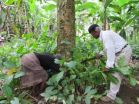(Press-News.org) Twist, Snail, Slug. They may sound like words in a children's nursery rhyme, but they are actually the exotic names given to proteins that can generate cells with stem cell-like properties that have the ability to form diverse types of tissue.
One protein with the even more out-there name of ZEB1 (zinc finger E-box binding homeobox 1), is now thought to keep breast cancer cells from being successfully treated with radiation therapy, according to a study at The University of Texas MD Anderson Cancer Center in Houston.
Li Ma, Ph.D., an assistant professor of experimental radiation oncology at MD Anderson, reported in this month's issue of Nature Cell Biology that ZEB1 may actually be helping breast tumor cells repair DNA damage caused by radiation treatment by ramping up a first-line of defense known as DNA damage response pathway.
"Radiation therapy causes cell death by inducing DNA ' breaks'," said Ma. "The rationale for treating tumors with radiation without damaging normal tissues is that, compared with normal cells, tumor cells are actively dividing and often have defects in DNA damage repair machinery."
Tumor cells are thus less able to repair DNA damage. But not always. Sometimes the body produces tumor cells resistant to radiation. They are somehow able to "turn on" the DNA damage response apparatus. Until now, the question has always been how?
Ma's team has demonstrated that the wily tumor cell's ability to push the panic button at the last second can be triggered by ZEB1's penchant for launching an operation that generates cancer stem cells.
"The cancer stem cells have been shown to promote radioresistance through activation of the DNA damage response system," said Ma. "Our studies have shown that ZEB1 can induce a process known as epithelial-mesenchymal transition (EMT) which allows certain tumor to acquire cancer stem cell properties including radioresistance."
EMT is one way the body responds to wound healing and it is believed that cancer has found a method for using EMT to promote tumor progression.
ZEB1 achieves this unfortunate result through a complex chain of events that permit a gene known as ATM to stabilize the protein Chk1 that plays an important role in DNA damage response. ZEB1 promotes Chk1's ability to allow tumor radioresistance through deployment of an enzyme called USP7.
The hope is that new approaches to addressing radiation resistance may be developed through gaining better insight into how this signaling pathway keeps tumor cells growing despite being bombarded with toxic radiation treatments.
"Radiation therapy plays a key role in breast cancer management," said Ma. "To overcome the obstacle of radioresistant tumor cells, it is important to identify the critical causes and to develop safe and effective new methods for treatment including the possible use of agents that target ZEB1 and which inhibit CHK1."
INFORMATION:
Ma's study included collaborators in MD Anderson's Departments of Molecular and Cellular Oncology, Radiation Oncology, and Bioinformatics and Computational Biology. Other participating institutions included the University of Louisville Health Sciences Center in Louisville, Ky., the Houston Methodist Research Institute, China Medical University, Taiwan, and The University of Texas Health Science Center Graduate School of Biomedical Sciences in Houston.
The study was funded by the National Institutes of Health (R00CA138572, R01CA166051, R01CA181029 and U54CA151668) and a Cancer Prevention Research Institute of Texas scholar award (R1004).
Protein ZEB1 promotes breast tumor resistance to radiation therapy
2014-08-04
ELSE PRESS RELEASES FROM THIS DATE:
Phases of clinical depression could affect treatment
2014-08-04
Research led by the University of Adelaide has resulted in new insights into clinical depression that demonstrate there cannot be a "one-size-fits-all" approach to treating the disease.
As part of their findings, the researchers have developed a new model for clinical depression that takes into account the dynamic role of the immune system. This neuroimmune interaction results in different phases of depression, and has implications for current treatment practices.
"Depression is much more complex than we have previously understood," says senior author Professor Bernhard ...
Analysis of African plant reveals possible treatment for aging brain
2014-08-04
LA JOLLA—For hundreds of years, healers in São Tomé e Príncipe—an island off the western coast of Africa—have prescribed cata-manginga leaves and bark to their patients. These pickings from the Voacanga africana tree are said to decrease inflammation and ease the symptoms of mental disorders.
Now, scientists at the Salk Institute for Biological Studies have discovered that the power of the plant isn't just folklore: a compound isolated from Voacanga africana protects cells from altered molecular pathways linked to Alzheimer's disease, Parkinson's disease and the neurodegeneration ...
Becoming bad through video games
2014-08-04
Previous studies show that violent video games increase adolescent aggressiveness, but new Dartmouth research finds for the first time that teen-agers who play mature-rated, risk-glorifying video games are more likely subsequently to engage in a wide range of deviant behaviors beyond aggression, including alcohol use, smoking cigarettes, delinquency and risky sex.
More generally, such games – especially character-based games with anti-social protagonists – appear to affect how adolescents think of themselves, with potential consequences for their alter ego in the real ...
Still no 'justice for all' for female athletes
2014-08-04
Spanish hurdler María José Martínez-Patiño, who in the 1980s endured harsh global media attention when she was subjected to unscientific gender tests, is co-author of a study that takes stock of current sexual verification policies in athletics. While such policies were originally designed to weed out men who impersonate women at female-only events, issues of privacy and confidentiality remain paramount to safeguard athletes from unnecessary embarrassment, says Nathan Ha of the University of California Los Angeles in the US, lead author of the review in Springer's journal ...
Attention, bosses: web-surfing at work has its benefits
2014-08-04
A new e-memo for the boss: Online breaks at work can refresh workers and boost productivity. Early findings from a University of Cincinnati study will be presented on Aug. 5, at the 74th annual meeting of the Academy of Management in Philadelphia.
The study led by Sung Doo Kim, a doctoral candidate in the Carl H. Lindner College of Business, opens a rare avenue of research into coping with technology-induced distractions in our contemporary society.
Previous research has focused on breaks during off-job hours such as evening, weekend and vacation periods, or on traditional ...
Fruit flies going high-tech: How touchscreen technology helps to understand eating habits
2014-08-04
A new study reveals surprising similarities between the way mammals and flies eat. What and how we eat is a crucial determinant of health and wellbeing. Model organisms such as fruit flies have provided crucial insights into how our brain decides what and how much to eat. But until now it was not clear how similar eating was in fruit flies and mammals (vertebrates).
In a paper published today (Itskov et. al 2014) in the scientific journal Nature Communications, scientists from the Champalimaud Neuroscience Programme, Lisbon, Portugal, in collaboration with the University ...
Nanoscale details of electrochemical reactions in electric vehicle battery materials
2014-08-04
UPTON, NY-Using a new method to track the electrochemical reactions in a common electric vehicle battery material under operating conditions, scientists at the U.S. Department of Energy's Brookhaven National Laboratory have revealed new insight into why fast charging inhibits this material's performance. The study also provides the first direct experimental evidence to support a particular model of the electrochemical reaction. The results, published August 4, 2014, in Nature Communications, could provide guidance to inform battery makers' efforts to optimize materials ...
Eating resistant starch may help reduce red meat-related colorectal cancer risk
2014-08-04
PHILADELPHIA — Consumption of a type of starch that acts like fiber may help reduce colorectal cancer risk associated with a high red meat diet, according to a study published in Cancer Prevention Research, a journal of the American Association for Cancer Research.
"Red meat and resistant starch have opposite effects on the colorectal cancer-promoting miRNAs, the miR-17-92 cluster," said Karen J. Humphreys, PhD, a research associate at the Flinders Center for Innovation in Cancer at Flinders University in Adelaide, Australia. "This finding supports consumption of resistant ...
Video-game playing for less than an hour a day is linked with better-adjusted children
2014-08-04
A new study suggests video game-playing for less than an hour a day is linked with better-adjusted children and teenagers. The research, carried out by Oxford University, found that young people who indulged in a little video game-playing were associated with being better adjusted than those who had never played or those who were on video games for three hours or more. The study finds no positive or negative effects for young people who played 'moderately' between one to three hours a day. However, the study, published in the journal, Pediatrics, suggests that the influence ...
WSU researchers see violent era in ancient Southwest
2014-08-04
PULLMAN, Wash.—It's a given that, in numbers terms, the 20th Century was the most violent in history, with civil war, purges and two World Wars killing as many as 200 million people.
But on a per-capita basis, Washington State University archaeologist Tim Kohler has documented a particularly bloody period more than eight centuries ago on what is now American soil. Between 1140 and 1180, in the central Mesa Verde of southwest Colorado, four relatively peaceful centuries of pueblo living devolved into several decades of violence.
Writing in the journal American Antiquity, ...



